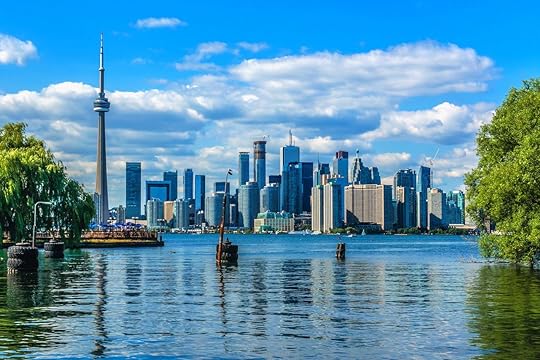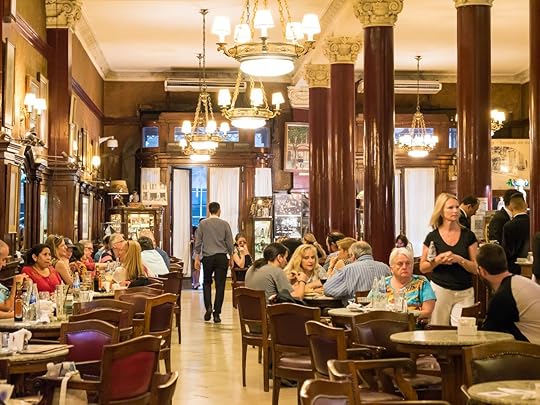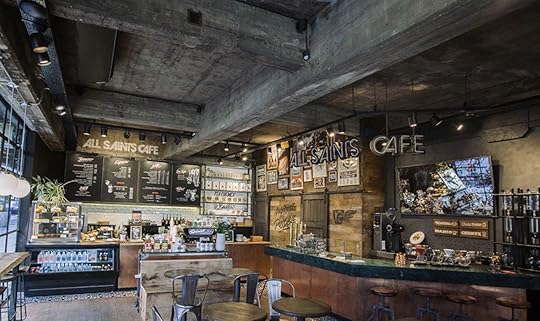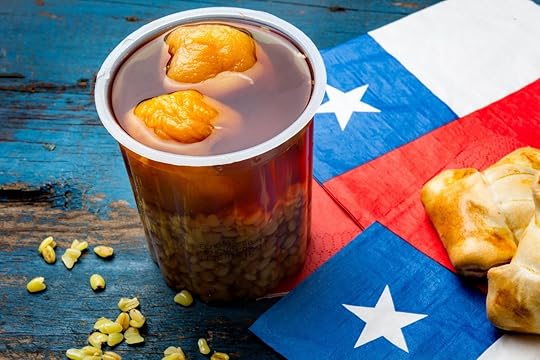Matador Network's Blog, page 1042
August 2, 2019
New Universal Studios Epic Universe

Universal Studios just announced a new “epic” theme park in Orlando — without actually saying what it is. On the heels of Disney’s popular new Star Wars-themed attractions, Universal needs a fresh concept to compete. Yesterday morning, it held a press conference announcing plans to build the new park, located just a few miles from other attractions, but no actual details were revealed about what exactly would be inside, except that it would be “the most immersive and innovative park [it has] ever created”
At least this piece of concept art was released to tide us over for a bit.

Photo: Universal Studios
The only other information available comes in the form of a press release, which states that the new park “will offer an entirely new level of experience that will forever change theme park entertainment. Guests will venture beyond their wildest imagination, traveling into beloved stories and through vibrant lands on adventures where the journey is as astounding as the ultimate destination.”
It’s pretty vague for now, but you can sign up on the website to be notified of the latest news regarding the park. 

More like this: The 7 strangest theme parks around the world
The post Universal Studios announces plans for a new Epic Universe appeared first on Matador Network.

Cheap Labor Day vacations

Painful as it might be to accept, summer is nearing its home stretch. Sorry, somebody had to break it to you. Not that you shouldn’t get out and enjoy the last full month of summer to its fullest, but you might also want to start thinking about the season’s last big hurrah.
With Labor Day weekend starting in August this year, you’ve only got a few weeks to plan a warm-weather getaway. And on short notice, looking for somewhere close and cheap should be a priority. Here are a dozen locations driving distance from major cities that are affordable, interesting, and something different from the usual Labor Day locales.
1. Charlotte, North Carolina

Photo: digidreamgrafix/Shutterstock
In tourism-happy North Carolina, sometimes its largest city gets overlooked when considering places to visit. But don’t sleep on Charlotte, where you can get drinks at the best rooftop bar in the state at Fahrenheit before heading out to acclaimed restaurants like Angeline’s and Merchant & Trade, paying a fraction of what you would in Charleston. The city also just opened the spanking-new Optimist Hall, a 30,000-square foot food hall from the makers of Atlanta’s Krog Hall, featuring 20 local vendors.
Charlotte’s also home to the US National Whitewater Center, where the Catawba River offers the most challenging artificial rapids in the world. Early September brings ideal temperatures to this part of the country, perfect for enjoying a game at BB&T Ballpark, a minor league stadium that you’d swear was in the big leagues if you didn’t know any better.
2. Grenada

Photo: Pawel Kazmierczak/Shutterstock
The tastiest island in the Caribbean might not be especially easy to get to, per se. But if you’re tempted by the chocolate, cinnamon, and bright colors of the Spice Island you won’t find a cheaper time to go than September. That’s when Grenada kicks off its Next Stop Grenada campaign, offering deep discounts all over the islands on everything from hotels to restaurants to scuba diving.
You can peruse the bevvy of offers here, but some highlights include 20 percent off at hotels like the Green Roof Inn in Carriacou, 40 percent off at Silversands, and 25 percent off at the Mount Hartman Bay Estate. You can also get free room upgrades and complimentary massages at some hotels, and half off your dive buddy’s dives and room at the Aquanauts Resort.
3. Spartanburg, South Carolina

Photo: Kevin Ruck/Shutterstock
Long relegated to the shadow of its small-city-darling neighbor Greenville, Spartanburg is starting to come into its own as a legitimate destination. No time is better to discover it than Labor Day weekend, when the city gets a jump on Oktoberfest with SpartOberfest. You’ll be transported from late-summer South Carolina to mid-fall Central Europe, where traditional Oktoberfest German food, beer, and music are joined by a Christmas Market — if the holidays just can’t come soon enough for you.
You can enjoy all the southern-food staples you’d pay a lot more for elsewhere – from pimento cheese fritters at Cribbs Kitchen to buttermilk pie ant Blue Moon Specialty Foods. No, it won’t be a healthy Labor Day in Spartanburg. But it will be all you’d expected from a late-summer Carolina getaway.
4. San Diego, California

Photo: Dancestrokes/Shutterstock
Not that spending a long weekend in San Diego is a groundbreakingly novel idea, but September typically brings the warmest temperatures of the year to Southern California, so it’s your best chance to have uninterrupted, balmy beach days. It’s a fairly easy drive from anywhere in the west, and you can find loads of cheap flights on Southwest and Alaska Airlines from anywhere in California.
Once there, you can enjoy the sands along Pacific or Mission Beach, gorge yourself silly in one of America’s best Little Italys or take in some live horse racing at Del Mar. The Chargers may be gone but the San Diego Padres still have a month left in their season, and even if you don’t like baseball, Petco Park is one of the best atmospheres in the game.
5. Greenwich, Connecticut

Photo: James Kirkikis/Shutterstock
Looking to get out of the hectic NYC-area for Labor Day, but don’t want to deal with airports, shore houses, or anything involving the Hamptons? Jump on a train and head out to Greenwich, an affordable, easy ride from the city and so much more than a bougie bedroom community. It’s an ideal place to relax in nature, where you can birdwatch in the serenity of the Sachem Nature Preserve, meditate on the water at the Mianus River Park, or breathe in fresh oxygen as you run along the seven miles of trails at Audubon Greenwich.
You’ll have a far more serene beach scene than almost anywhere near New York when you hop on the Greenwich Island Beach Ferry to Island Beach. Or spend the say at a civilized public swimming pool in Byram Shore Park. Finish the day by grabbing some fresh oysters at the Elm Street Oyster House, and wonder why you hadn’t escaped to Greenwich sooner.
6. Miami, Florida

Photo: littlenySTOCK/Shutterstock
Very little in Miami is ever actually cheap. But as South Florida moves into fall with sticky-hot weather and perpetual threat of hurricanes, prices are as low as they’re ever going to be. This is best evidenced during Miami Spice, the city’s two-month restaurant promotion where spots that usually charge $32 for a chicken salad offer solid three-course menus for $39.95. The best deals are probably at Byblos — a middle-eastern fine dining spot that serves almost six courses — and any of the city’s best steakhouses like Red, StripSteak, and Bourbon Steak, which offer full steak dinners for less than what one cut usually costs.
If you’d rather not pay for food at all, a couple of Miami hotels are offering shoulder-season deals that make Spice look costly. The new Hyde Midtown Miami, for example, has a 20 percent off its normal rates and a $100 credit, which should be enough for one meal. Or you can stay on the beach at the Sole Miami and get up to $600 resort credit there, effectively paying for no food during your entire stay.
7. Rocky Mountain National Park

Photo: Sean Xu/Shutterstock
National parks during holiday weekend can create quite the conundrum: With record crowds your options are either dropping painful premiums at in-park lodges or cramming yourself into crowded campgrounds where you’ll wait 30 minutes to take a shower, if you can take one at all. Then sleeping on the hard ground after a nutritious dinner of beef jerky and Clif bars.
Not so at Rocky Mountain National Park, the odd national park with a YMCA right outside its gates. It’s fun to stay there, especially with log cabin-style accommodations where you can get yourself clean, have a good meal, and sleep your entire family in multiple rooms for less than $300 a night. You’ll find many ways to have a good time, including horseback riding, rock climbing, whitewater rafting, fishing, archery, and other outdoor pursuits. Construction worker and cop outfits not included.
8. Toronto, Ontario

Photo: Kiev.Victor/Shutterstock
There are a limited number of months where you can hop over the border and visit the third-largest city in North America during good weather. But Labor (or Labour, if you want to go native) Day weekend puts you smack in Toronto’s sunny season, where you can hit its surprisingly good beaches or take in a Jays game at the Rogers Centre while the roof is still open. Summer mania — and the festival season that comes with it — has died down, and the city sits in a shoulder season where great rates on hotels abound. Especially with the favo(u)rable exchange rate.
In the city you’ll hear over 130 languages, and eat in one of three Chinatowns or suburbs like Brampton with the best Indian food in North America. Stick to the holes-in-the-wall and you’ll never spend much. You can also enjoy the blue skies while strolling the Toronto Zoo, or head inside and explore the Bata Shoe Museum, Casa Loma, and the Hockey Hall of Fame.
9. Lexington, Kentucky

Photo: ehrlif/Shutterstock
The heart of the Bluegrass State brings you closer to horses, bourbon, and calming rolling hills, with hotels, restaurants, and attractions cheaper than you’ll find in big cities. In Lexington you can hobnob with championship race horses at their retirement home — the Kentucky Horse Park — or visit Triple Crown winner Justify as part of the Horse Country program for $20. A tour of the fabled Woodford Reserve distillery is a scant $14. And you can take a tour of Kentucky breweries with the Brewgrass Trail Passport and pay about $8 a flight.
Staying here is cheap too, as the city’s top boutique hotels like the Origin Hotel and the Campbell House have rates less than $150 a night. And Hilton Sire Hotel, which will coordinate visits out to horse country for you, runs less than $150 a night as well.
10. Tupelo, Mississippi

Photo: Blue Canoe/Facebook
Nashville during Labor Day is going to be bachelorette party hell. Memphis might be less crowded, but can still be expensive. Instead, hit the third part of the Delta music triangle and stop in the birthplace of Elvis Presley; Tupelo, Mississippi. The city’s set up a self-guided Elvis Presley bike tour, where you can stop by the King’s most storied stomping grounds at your own pace, totally free.
Tupelo is also teeming with Deep South culture, the kind of foreign escape one looks for in travel. Stop at Clay’s House of Pig — located in a bait and tackle shop — where you’ll find the richest slow-cooked pulled pork in the state. Or head to King’s Chicken Filiin’ Station, an old service station with full fried chicken meals for less than $10. At night, stop into the Blue Canoe for country, rock, and blues acts as good as you’d find north in Tennessee. Plus, there are cheap craft beers and a burger topped with so much that it barely fits in your mouth.
11. Buffalo, New York

Photo: Leonid Andronov/Shutterstock
Though Buffalo has a great many great things to brag about — from historic architecture to the Albright-Knox Gallery — what most people know about it are its wings. And Labor Day weekend brings the biggest Buffalo wing gathering in the world to the shores of Lake Erie with the National Buffalo Wing Festival. Over 70,000 visitors from every state and 44 countries descend on Nickel City to sample wings made by America’s finest restaurants.
Once you’ve gotten your fill of wings, burn at least a few of them off by kayaking through old grain silos in Silo City. Or scaling the climbing wall alongside another old silo at RiverWorks. You can also visit the Martin House Campus, a Frank Lloyd Wright-designed mansion that just finished a $50 million refurbishment. And you can spend Labor Day sleeping in an old mental hospital at the Hotel Henry, a gothic maze of a luxury hotel that’s one of the most unique lodgings in the country.
12. Reno, Nevada

Photo: Hammon Photography/Shutterstock
If you’re more into gambling and outdoors than $20 drinks and club lines, Reno is the ideal Labor Day alternative to Las Vegas. The Biggest Little City in the World still offers the disturbingly cheap hotels rooms and prime rib buffets of yesteryear, but has added some serious mountain recreation to go along with it. Head to the Whitney Peak Hotel and scale the world’s largest climbing wall for $17 a day ($10 for hotel guests). Then try the Mount Rose Trail and hike up to 360-degree vistas of Lake Tahoe. Those hikes are free.
In town, Labor Day brings the Best in the West Nugget Rib Cook-Off, where 240,000 pounds of ribs and live music are all available at no cost. You can walk it off while scoping the city’s best art during an Art Spot Reno tour for $10. Or you can meander along the Truckee River and enjoy the view of the mountains beyond, keeping an eye out for any errant Burners who happen to wander into town. 

More like this: The best places to travel this September
The post Need a last-minute Labor Day getaway? Here are 12 easy, affordable options appeared first on Matador Network.

Best coffee shops in Buenos Aires

The coffee scene in Buenos Aires, Argentina, is captivating. Even though porteños (Buenos Aires locals) always seem to be stressed and in a hurry, they stop, sit, and enjoy for hours when it comes to coffee.
To understand why, you must simply have a cortado in a historic cafe. The quality of the coffee won’t be the star, but you’ll immerse yourself deep in porteño culture. Then, experience the city’s ever-growing specialty coffee movement in shops where you can nerd out with the baristas and finally have that flat white you’ve been longing for.
These are the two sides to coffee culture in the Argentinian capital, and both are equally important. Buenos Aires is a city of contrasts where the classical and the modern coexist, and the coffee scene is a perfect place to experience both the old and new.
Buenos Aires’ best historic cafes

Photo: TasfotoNL/Shutterstock
Buenos Aires is a historically rich city, and travelers don’t need to go on an expensive tour to get a feel for what the city was like during its golden age. Instead, walk through Microcentro and stop at a bar notable for a cup of coffee and a slice of cake. Bares notables are historic cafes that are significant contributors to the capital’s cultural heritage, and there are more than 70 recognized bares notables today. Inside, the decor remains untouched and walking through a bar notable’s doors can feel like traveling back in time.
One of the most popular among tourists is Café Tortoni, which dates back to the 1850s. It’s the oldest cafe in the city, and is known for past regulars like painter Quinquela Martín, writer Jorge Luis Borges, and tango singer Carlos Gardel. There’s often a line of people at the door waiting for a table, particularly on nights when the cafe hosts tango shows. Arrive early on show nights and, no matter when you visit, allow for plenty of time. No one is in a hurry here.
There are other options for people who aren’t a fan of lines. Visit El Viejo Buzón in Caballito, where the decorations mostly consist of old football jerseys hanging from the ceiling, for a neighborhood feel. Las Violetas features classic Art Nouveau decor, and was voted the best historic cafe by locals in 2017. Grab a cuppa at London City and people watch as crowds come and go in the frenetic financial district. Finally, Don Victoriano, formerly known as El Gato Negro, is where to go for a twist on the historic. Here, the coffee is roasted in the same machine as it has since opening in 1920, and you can order coffee with spices like cardamom, or with milk and turmeric.
Chances are high that the coffee won’t be the best you’ve ever had at any of these spots, but you’ll be looking through the same window Gardel and other historic figures used to gaze through. If that doesn’t convince you, there’s always the pastries.
How to order at a historic Buenos Aires cafe

Photo: RUBEN M RAMOS/Shutterstock
The first words you need to know when ordering at a bar notable are cortado and lágrima. A cortado is an espresso with a dash of hot milk, while a lágrima is mostly milk with a dash of espresso.
Coffees are served in two main sizes — pocillo, the smallest espresso cup, and jarrito, which is slightly larger. Café chico (small coffee) is an espresso, and to order like a locals, make a letter C with your index finger and your thumb when ordering. For a regular coffee with milk, ask for a café con leche.
That’s all you need to know for porteño coffee 101. The second step is to order your drink of choice with two medialunas (sweet croissants).
Modern coffee culture in Buenos Aires

Photo: LAB. Tostadores de Café/Facebook
Over the last few years, Buenos Aires’ Palermo district has become the hub of a Latin-American specialty coffee explosion, which has since expanded across the city. At the center of the scene is LAB, one of the first coffee roasters to open its shop in Palermo back in 2014. LAB offers espresso and a variety of filter-style coffees like V60, Chemex, and Aeropress, but the drink that defines its legacy is the flat white.
The cafe’s organization allows customers to engage with the baristas and learn about the coffee beans and extraction methods. If you want to learn more, sit at the big bar with high stools that surround the coffee machine.
This new style of cafe has been a learning experience for the people used to the historic style, where coffee is served hot and in full cups. In these new shops, beverages are served at drinking temperature, and the menus lack options like jarritos, lágrimas, and cortados. LAB baristas have bridged the gap by taking time to converse with customers as they sit with their flat whites, slowly turning this new market into a trend.
The best option for vegans and non-dairy consumers is Birkin, which has locations in Botánico and Palermo with options of soy or almond milk. Birkin is perhaps the most innovative cafe in town, having added a matcha latte and a golden latte made with turmeric to its menu, both available with dairy or non-dairy milk.
The best modern cafes in Buenos Aires

Photo: All Saints Cafe
Modern coffee culture is easier and easier to find as porteños continue to embrace newer brews. Many, such as Cigaló in Doho and Duca in Palermo, resemble cafes in Melbourne and New York City. Negro has a number of locations in the center of Buenos Aires, and the flat white here rivals the one at LAB. Coffee Town is a little shop worth a visit in the heart of the San Telmo Market. In Recoleta, stop by The Shelter. All Saints Cafe is like Argentina’s version of Starbucks. Both locations, in Belgrano and downtown, offer everything from caramel frappuccinos to flat whites. 

More like this: Everything you need to know about asados in Argentina
The post The ultimate guide to Buenos Aires’ thriving coffee scene appeared first on Matador Network.

Saudi Arabia lifts travel laws

In a landmark policy change for Saudi Arabia, the famously conservative country will now allow women over the age of 21 to apply for a passport without male authorization and travel abroad without a male guardian.
Crown Prince Mohammed bin Salman has taken steps to relax prohibitions on women, including the ability to register births, marriages, and divorces, and be the legal guardian of minors. Previously, the male guardianship system required that women obtained permission from their guardian — a husband, father, or other male relative — to travel, get a passport, undergo certain medical procedures, and get a job.
According to The New York Times, the new regulations also cover employment, outlawing discrimination of workers based on gender, disability, or age.
It was only one year ago, in June 2018, that women in Saudi Arabiawere granted the right to drive. 

More like this: How to get a Saudi visa and what to do once you get there
The post Saudi Arabia allows women to travel without male guardians appeared first on Matador Network.

Sri Lanka offers free one-month visa

In an attempt to boost its tourism industry after the Easter bomb attacks that killed over 250 people including 42 foreign nationals, Sri Lanka is giving free 30-day visas on arrival to tourists and visitors on business from 48 countries.
This new measure started on August 1, and will be reviewed after six months. According to USA Today, Sri Lankan authorities previously charged between $20 and $35 for one-month tourist visas and required applications online, at embassies, or consulates.
Citizens from the US, Canada, Australia, New Zealand, Thailand, South Korea, Singapore, Malaysia, Cambodia, European Union nations, Switzerland, Denmark, Sweden, Norway, Finland, Iceland, and Russia are among the nations included in the measure.
According to Reuters, tourism in Sri Lanka was down 13.4 percent for the first half of 2019. 

More like this: 10 unmissable experiences that will put Sri Lanka firmly on your bucket list
The post Sri Lanka is now offering free one-month visas on arrival appeared first on Matador Network.

August 1, 2019
Modern history of Israeli wine

For much of the world, Israeli wine is associated with kosher wine. At best, it’s associated with family and tradition. At worst, it’s relegated to something sweet and cheap. Yet millennia before France, Italy, and Spain became go-to countries for good wine, Israel was a world-class wine-producing region. Now, it’s reclaiming its position.
Israel is sort of like the oldest possible young wine region. It has a long history, but the country’s wineries have only been making consistently high-quality dry wines in the last couple of decades. Israeli winemakers have already caught the eye of the wine press and in-the-know drinkers. Producers in the country have won awards like the Best Syrah in the World in 2010 at the Decanter World Wine Awards, and an Israel winery was dubbed New World Winery of the Year in 2012 from Wine Enthusiast. It’s about time for everyone else to start paying attention.
“There’s so much to know and not that much Israeli wine out there,” said Anne Markovich-Girard, vice president of sales at Yarden Wines. “Which makes you think maybe there’s not much to know, but that’s just not true.”
The first Israeli wines

Photo: Galil Mountain Winery
Evidence of early winemaking is everywhere in Israel. A wine press dating back more than 2,000 years was found in 2016, the oldest uncovered but far from the only ancient press. Writing on a papyrus scroll from the seventh century BC that some believe is the first reference to Jerusalem has an order for “jars of wine.” And it’s no secret that wine flows freely in biblical stories. Grapes are one of the seven blessed foods in the book of Deuteronomy along with wheat, barley, figs, pomegranates, olives, and honey.
Wine production came to a halt in the seventh century AD, when the region was a part of Muslim Palestine. Islam prohibits alcohol, and the only grapes allowed were food grapes. Strict bans on alcohol continued, with a short interval during the Crusades, through the Ottoman Empire in the 19th century.
Commercial winemaking didn’t return until the 1880s. Baron Edmond de Rothschild, who owned the esteemed Lafite Rothschild in Bordeaux, sent French grapevines and production techniques to Israel to help establish Carmel Winery. The winery today is the longest continuously running vineyard in Israel. Due to market pressures, however, the focus at Carmel for the first 50-plus years was sweet kosher wines.

Photo: יקבי כרמל – Carmel Winery/Facebook
The 1960s marked a turning point. Carmel started making Bordeaux-style dry wines, which was the spark that led to the winery winning the Best Syrah in the World in 2010. Golan Heights Winery, the 2012 New World Winery of the Year winner, released its first vintage in 1984, followed by the boutique Margalit Winery in 1991. There are now more than 320 wineries in the country, according to Wines Israel.
It’s impossible to talk about the growth of modern Israeli wine, however, without mentioning the region’s disputed territories. Much of Golan Heights has been occupied by Israel since 1967, bolstered by Israel’s Golan Heights Law in 1981 that’s not supported by the United Nations. Parts of the West Bank, including wine-producing areas, are considered an administrative region by Israel and a Palestinian territory by much of the rest of the world. The European Union addressed wine from the disputed territories in 2015 with a move to label wines from parts of the West Bank, East Jerusalem, and Golan Heights as a product from an “Israeli settlement.”
These tensions aren’t lost on producers and consumers, but it hasn’t slowed the innovation happening in the country by much.
New World winemakers and Old World grapes

Photo: Galil Mountain Winery
Most of Israel’s indigenous grapes have long been lost, though it’s believed that syrah comes from the Middle East, as well as a few lesser-known varieties like marawi and dabouki. That means that unlike countries like Italy, where wines are made from hundreds of indigenous varieties, Israel relies on Old World grape varieties in its five modern winegrowing regions: Galilee, Shomron, Samson, Judean Hills, and Negev.
As the number of wineries in Israel grew, so did its reputation among winemakers. Today, you’ll find winemakers from California, Australia, and elsewhere working in the region and bringing different techniques and styles to Israel’s vineyards. A good example is Michael Avery, the Australian winemaker at Galil Mountain Winery.
Galil has vineyards in the northern reaches of Israel along the coast and in the mountains. Much of Israel is hot, but its vineyards are at an elevation where there’s intense diurnal temperatures, low humidity, and seasons (it’s not rare for it to snow in the winter).

Photo: Galil Mountain Winery
“Winemakers in Israel, we’re very lucky,” Avery said. “Low rain, moderate temperature, and you can see that in the wines.”
Varied soil types in the region are ideal for grape varieties from France and Portugal, while the Mediterranean climate encourages varieties from Spain and Italy. Avery and his team use cutting-edge technology to measure the hottest points of the day throughout the year in specific vineyard blocks and plant accordingly. The team is constantly working to find the varieties best suited for the area, which has recently led to more grenache, syrah, and petit verdot. Galil Mountain is also using post-harvest techniques to improve its wines, like aging its sauvignon blanc on the lees to add texture.
Modern techniques are crucial to good wine, as Israel is one of the southernmost wine countries in the northern hemisphere.
These new techniques in one of the world’s most historic wine regions have made Israeli wine among the best in the world. Israelis and winemakers looking to make their mark are already well aware of this, now it’s time for everyone else to forget the sweet kosher wine past and seek out a taste of what makes modern Israeli wine so desirable.
Israeli wineries to know
Carmel Winery: It’d be a shame to taste through Israeli wines without tasting where the country’s modern wine industry started. Carmel Winery had a major facelift in 2000 after an investment in modern infrastructure and equipment, and has been expanding ever since. Its wines are easily found in Israel and abroad.
Galil Mountain Winery: Sourcing from six vineyards around the Upper Galilee mountain range, Galil Mountain Winery started in 2000 with the help of Golan Heights Winery. It uses modern techniques with a sustainability mindset to create a range of red, white, and rosé wines. The red blends Alon and Ela are favorites.
Cremisan Wine Estate: Located in Bethlehem, Cremisan foregoes international grape varieties to focus on Palestinian grapes like baladi, marawi, and dabouki. It’s hard to find the brand’s wines outside of Israel, but it’s worth seeking out to try wines made from grapes grown in the region for thousands of years. 

More like this: The 7 best places for a low-cost wine trip
The post It’s time for wine drinkers to start paying attention to Israeli wine appeared first on Matador Network.

The best banks for travelers

It’s important to have easy access to your money when traveling abroad. While the days of traveler’s checks and long bank queues are mostly gone, ATM and foreign transaction fees can still cost a pretty penny. Fortunately, as more and more banking is done online, managing your money while traveling is getting easier. Helpful technology means less wasted time at airport money exchange kiosks and fewer hefty fees — at least if you choose the right bank.
There are four key factors that play a role in which bank regular travelers should use:
International transaction or ATM fees. While international fees are typically low — often less than 50 cents per transaction — they can add up over the course of a long trip.
Wire transfer fees. Being charged for a wire transfer is the last thing you want when you’re stuck without money and in need of emergency help.
Ease of contact in case your card is flagged or another issue arises.
Ability to link your account to online payment methods like Apple Pay and Google Pay.
Another thing to keep in mind is the currency exchange markup. Currency exchange markup is a term frequent international travelers absolutely loathe. The best banks for international travel take this into consideration and eliminate it from the company’s vocabulary. Whether you’re applying for a travel rewards credit card or opening a new bank account, identify options that use the Mastercard Currency Converter to determine the transaction conversion from USD to the local currency. The Mastercard rate is generally the most favorable for travelers.
Keep these points in mind when searching for where to keep your money. A better bank means more time looking at your travel photos and less time staring in disbelief at all those fees on your bank statement. These are the best banks for travelers.
For travelers from the US: Charles Schwab

Photo: rblfmr/Shutterstock
The High Yield Investor Checking Account from Charles Schwab is the best checking account a frequent international traveler from the United States can have, hands down. While some other checking accounts ditch international fees, Chuck Schwab also ditches the minimum balance requirement often required to receive the perk. The account also links with most online payment platforms.
What you get
No ATM fees or foreign transaction fees. Charles Schwab issues a rebate for any fees incurred from other banks as well.
No monthly fee.
An annual yield of .37 percent. This is significantly more than the .1 percent offered by standard checking accounts, but still isn’t much unless you keep at least a $5,000 balance. At that point, you essentially offset one overpriced airport meal each year.
You can apply if
You’re a US citizen or permanent resident and have a US mailing address.
The catch
The High Yield Investor Checking account is paired with a Charles Schwab brokerage account, and the application requires a dive deep into your financial records. This can be a positive, however, if long-term investing is part of your financial plan. Many dedicated investors aren’t keen on linking accounts, but for the frequent traveler who prioritizes the ease of automation, this can be a serious time-saver. There’s also no minimum balance for the brokerage account.
For international travelers and those who prefer going to a physical bank: HSBC

Photo: Serge Cornu/Shutterstock
HSBC is a British bank with nearly 4,000 locations in 67 countries. You’d be hard pressed to walk more than a few blocks in a major European, Asian, or Latin-American city center without passing an HSBC ATM. The basic checking accounts allow you to move money between accounts in multiple countries, though you’ll need an account in your home country. Thanks to a global presence ATM fees are all but nonexistent, but HSBC does charge foreign transaction fees on debit card purchases unless you have the Premier checking account.
What you get
No wire fees, foreign transaction fees, or ATM fees with the Premier account.
International banking and in-person customer service.
Peace of mind of knowing you can easily withdraw money just about anywhere.
You can apply if
You live in one of the 67 countries where the bank operates, including the US.
The catch
In 2012, HSBC paid a nearly $2 billion fine after being accused of money laundering in the US, so you’d have to live with the fact that your bank helped Mexican and Colombian drug cartels — and potentially other shady operations — do business.
For the modern nomad: N26

Photo: N26/Facebook
N26 does business a little differently. It’s not tied to the old way of doing things, meaning no in-person visits, no lines, no free lollipops at the drive-thru, and no weird calls from an 800 number trying to get you to upgrade. It’s contemporary in every sense of the word. Everything can be done online, and the basic checking account is designed for people who regularly country hop, particularly in Europe.
Similar to mobile apps like Qapital, N26 has features like automated savings toward designated goals and dates. N26 opened to US travelers in July. Unless you signed up months ago you’ll be added to the waiting list for an account, which N26 claims shouldn’t take longer than a few days.
What you get
No foreign transaction fees.
No minimum balance or monthly fees.
All bank interactions are done online, from deposits to customer service to account opening.
A debit card intended for international use, meaning it won’t be flagged the second you stick it in a foreign ATM.
You can apply if
You’re a European or US resident with a European or US mailing address.
The catch:
The US rollout isn’t complete yet, so there may be a wait. It also costs $2 plus 2 percent of the total withdrawal when taking money out of an ATM. Also, there aren’t any physical bank locations, so you’re out of luck should you need to stop by for a chat. 

More like this: The Apple Card is coming in August. Here’s what travelers should know
The post The best banks for international travelers appeared first on Matador Network.

Eastbound jet lag is worse than west

Jet lag affects everyone differently. When you ask your friends about their jet lag, everyone will have a different answer. Some will say it’s worse going eastbound, some will say westbound, and the absolute worst answer to hear is “I don’t get jet lag at all.” Much of this pesky phenomenon depends upon the individual, but now there’s actually a study that claims to have solved the mystery of jet lag once and for all. The Sleep Cycle Institute examined more than 1.5 million nights’ worth of sleep data from people traveling in all directions, across a variety of time zones, and determined that traveling east is, in fact, much worse for sleep than traveling west.
In looking at the first five days of travel, the study showed that people have far less severe jet lag when they travel west. Not only that, but their quantity and quality of sleep, and their wake-up mood, actually improve over those who haven’t even traveled at all.
Interestingly, according to the data, travelers tend to sleep fairly well on the first night of their trip, but sleep quality declines on the second night — not fully returning to normal until day 10.
Dr. Catherine Darley, natural sleep expert, said, “Based on sleep physiology, it makes sense that westward travel is easier, as it is easier to lengthen the circadian rhythm. Not only is mood worse, but people can feel an increase in anger and performance problems. It’s important to note that these effects can last for several days and to take that into account when planning. For those people who travel regularly, there are strategies that can decrease the disruption caused by jet lag.”
Whatever science might say, jet lag remains a highly individual issue. One Matador Network writer, for example — who may or may not be recovering from jet lag at this very moment — would argue that westbound jet lag is why he hasn’t gotten a good night’s sleep in four days.
To each their own. 

More like this: How to use the science of routine to beat jet lag
The post Jet lag may only be a thing for westbound travelers, according to a new study appeared first on Matador Network.

American Airlines employee dancing

Flight taxiing usually isn’t very memorable (at least, not in a good way), but this American Airlines worker is defying the odds and livening up passengers’ journeys to the runway. Passenger Suzanne Durham noticed crew chief Isaiah Foster breaking into dance while she was waiting at her gate at Nashville International Airport, and posted the video on Twitter.
Whoever you are…THANK YOU! This @AmericanAir guy is living his #bestlife!
The best traditional Chilean dessert

Anyone who has the opportunity to travel to Chile must dedicate some time to appreciating the country’s vast array of sweets — before or after eating Chile’s best traditional dishes, your choice. Many of the traditional desserts include milk, lots of sugar, and manjar, otherwise known as dulce de leche. The desserts on this list are all traditional, local favorites that many Chilean people probably grew up eating.
1. Turron de vino
The Spanish brought turron, a nougat confection topped with nuts typically eaten around Christmas, to Chile in the colonial era. Since then, Chileans adapted the traditional recipe to include red wine, typically a cabernet sauvignon. To make turron de vino, a syrup made with sugar and wine is gently spun into the egg whites as they are being beaten, creating a whipped tower of creamy purple meringue. The wine gives the fluffy meringue an almost tie-dye effect. Turron de vino is served in glasses and topped with walnuts. You’re more likely to find this recipe in a grandmother’s house than on a restaurant menu.
2. Mote con huesillos

Photo: lgctr/Shutterstock
Technically a drink, mote con huesillos is a summertime favorite. It might not look very appealing but the taste is what’s important here. Dried huesillos (peaches) are cooked in sugar, water, and cinnamon and then mixed with mote, or fresh husked wheat. It’s eaten with a spoon, and at the end you’ll be able to enjoy the caramelized peach juice. Mote con huesillos are typically sold by street vendors, but can also be prepared at home. This drink is so distinctly Chilean that a common phrase in the country is “Más chileno que el mote con huesillo,” or “More Chilean than a mote con huesillo.”
3. Ice cream

Photo: ichywong/Shutterstock
Chile offers ice cream flavors you won’t find anywhere else. The most interesting flavors are inspired by fruits only found in South America, such as lucuma (colloquially known as the eggfruit) and chirimoya. If you visit northern regions of Chile such as San Pedro de Atacama you must try algarroba (or carob, which tastes similar to chocolate), and other varieties flavored with plants like chañar and rica rica, the aromatic leaves of which are also sometimes used to make a Pisco Sour. In the southern regions, you can sample maqui ice cream, which is made with a berry that’s found only in Patagonia.
4. Cuchuflí

Photo: nito/Shutterstock
While strolling along the beaches in the central region of Chile, enjoy a cuchuflí. This crunchy pastry, similar to the texture of a waffle cone without the ice cream filling, is rolled into a long tube, filled with manjar, and sometimes covered in chocolate. Cuchuflí is a popular street food sold by vendors pushing carts and stationed at stalls along the sidewalk, but can also be found in neighborhood bakeries and supermarkets. It’s a popular dessert in Argentina, too. While you can technically eat it at any time of day, these snack-able, cookie-like treats make a perfect accompaniment to after-dinner coffee.
5. Alfajores

Photo: Larisa Blinova/Shutterstock
This buttery round sandwich cookie (also known as chilenitos in Chile) is found throughout South America, as well as in the Philippines and Spain, where the cookie originates. The name of the cookie comes from the Arabic phrase al-hasú, meaning filled. Alfajores are typically filled with dulce de leche, and are often covered in powdered or glazed sugar, chocolate, or grated coconut. Jam is also occasionally used as a filling. Alfajores are found packaged in Chile, as well as in bakeries, and of course made at home. They’re such a popular snack that one chocolate-covered version of it has been dubbed the “Chilean Oreo.”
6. Torta de mil hojas

Photo: DB foto/Shutterstock
This cake of “1,000 leaves” is so named because its made by stacking layers of thin and crispy puff pastry filled with manjar and walnuts, similar to French mille feuille. It’s sometimes served in square, rather triangular, slices. The addition of a layer of acidic jam (like cherry or raspberry) can help cut some of the sweetness of so much dulce de leche, plus it adds a beautiful pink color to the final product. This cake is a staple at birthday parties, baby showers, and baptisms. If there’s a big party happening in a Chilean family, there will probably be torta de mil hojas on hand. It’s so popular in Chile that recipes for torta de mil hojas are typically passed down through generations.
7. Chirimoya alegre

Photo: Sutthiwat Srikhrueadam/Shutterstock
The name of this dessert literally means “happy chirimoya.” Chirimoya is a sweet and creamy fruit with an almost velvety texture that’s found in Chile, Peru, and Ecuador, and it’s perfectly suited to this simple, refreshing dessert. To make it, pieces of chirimoya fruit are combined in a glass with orange juice or whole slices of orange. You can add mint, powdered sugar, or cinnamon as a garnish, or pour condensed milk on top if you have a serious sweet tooth. Given the short ingredient list, this dessert is particularly easy to prepare at home. You can even add a shot of Cointreau to transform it into a cocktail.
8. Leche asada

Photo: Joao Kanashiro/Shutterstock
Meaning “roasted milk,” this baked dessert is very similar to flan. The ingredients — milk, eggs, vanilla, and sugar — are essentially the same. However, the consistency is slightly different. Leche asada is baked directly in the oven instead of in a water bath, adding a toasted layer of custard on top (as opposed to the completely smooth surface on flan). You’ll usually find this dessert in Chilean homes or supermarkets rather than in restaurants. Leche asada is most popular in Chile, Peru, and Colombia, where it’s also known as tres leches because heavy cream is sometimes added to give the custard a richer, creamier texture.
9. Kuchen

Photo: Josu Ozkaritz/Shutterstock
When Germans settled in Chile in the mid-19th century (with another resurgence following World War II), they brought with them many culinary traditions. Among the most popular today is kuchen, simply the German word for cake. Kuchen appears all over the country, and in Brazil, where it’s known as cuca. While this dessert may sound generic, Chileans have taken it to another level. This airy, fluffy cake is typically filled with fruit fillings and other toppings. Traditional variations include blueberry, apple, and raspberry. Another German-inspired dessert, pan de Pascua, similar to a Christmas fruit cake, is also popular in Chile.
10. Pie de limón

Photo: Erhan Inga/Shutterstock
Otherwise known as a lemon meringue pie, this dessert might not be originally from Chile, but remains a favorite of the region, where citrus fruits (like lemons and oranges) are especially popular. This tart citrus pie is made with a lemon-flavored custard and topped with mounds of fluffy meringue. In Chile, pie de limón is sometimes made with lemons, cream cheese, condensed milk, and a graham cracker crust. Lemon pie originates in France, but like many other desserts on this list that originated in Europe, it has found popularity all over South America.
11. Leche nevada
This classic dessert is especially popular in the southern region of Chile. Its nickname, Chilean Floating Islands, refers to its whipped, frothy appearance — a dollop of meringue, dusted with cinnamon, floats on top of an egg-based custard. Sometimes extra ingredients, like fruit jams or coffee, are added to the meringue to give it a little extra flavor. This dessert has a French origin; in the original version, a ball of meringue floats atop a pool of creme anglaise, usually on a plate rather than in a bowl. Leche nevada is served cold in a small glass and is eaten with a spoon. The simple custard and meringue takes just 10 minutes to prepare in your own kitchen. 

More like this: 9 traditional Chilean dishes the world needs to know
The post 10 Chilean desserts the world needs to know appeared first on Matador Network.

Matador Network's Blog
- Matador Network's profile
- 6 followers



